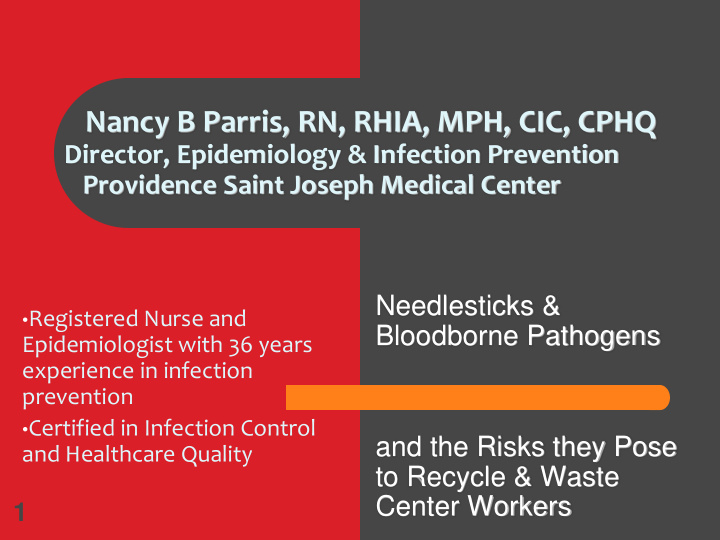



Nancy B Parris, RN, RHIA, MPH, CIC, CPHQ Director, Epidemiology & Infection Prevention Providence Saint Joseph Medical Center Needlesticks & • Registered Nurse and Bloodborne Pathogens Epidemiologist with 36 years experience in infection prevention • Certified in Infection Control and the Risks they Pose and Healthcare Quality to Recycle & Waste Center Workers 1
H OME I NJECTIONS • 9 million Americans use needles or other sharps at home • Generating each year • 3 billion used needles and other sharps • 900 million lancets • Patients are not well educated as to how to dispose of their home-generated sharps 2 Statistics provided by the US Environmental Protection Agency (EPA)
M EDICAL C ONDITIONS AND H OME -A DMINISTERED M EDICATIONS • Diabetes • Allergies • Arthritis • Cancer • Hepatitis • HIV/AIDS • Infertility • Migraines • Multiple sclerosis • Osteoporosis • Blood clotting disorders • Psoriasis • Growth hormone disorders • Pain control • Autoimmune disorders 3 Source: Food and Drug Administration (FDA)
S HARPS Medical term for devices with sharp points or edges that can puncture or cut skin Examples: Needles Syringes Lancets Auto Injectors Infusions sets 4 Connection needles/sets
5
6
7
8
HIV Over 1.1 million persons are living with HIV • infection in the United States No vaccine • No cure • Risk of infection following exposure • 0.3% (or about 1 In 300) • 9
HIV Lynda Arnold, RN • May 1992 – received her Nursing degree • September 1992 infected with HIV from a needlestick 10
HIV Over 1.1 million persons are living with HIV • infection in the United States No vaccine • No cure • Risk of infection following exposure • 0.3% (or about 1 In 300) • Very fragile virus • 11
H EPATITIS B B LOODBORNE P ATHOGENS Approximately 800,000 to 1.4 million persons • have chronic HBV infection in the United States 3,000 chronic liver disease deaths associated • with HBV Effective vaccines available • Risk of infection following exposure • 0% if vaccinated • 6 – 30% if susceptible • Very hearty virus • 12
H EPATITIS B 13
H EPATITIS C B LOODBORNE P ATHOGENS Approximately 2.7 – 3.9 million persons have • chronic HCV infection in the United States 12,000 chronic liver disease deaths associated • with HCV There is no vaccine • Risk of infection following exposure • 1.8 – 7% depending on the study • Very hearty virus • 14
H EPATITIS C "if [this photo of me in the end stage of Hepatitis C] could serve to improve the outcome of this devastating disease for others......." 15
B LOODBORNE P ATHOGENS Human Hepatitis B Virus Hepatitis C Virus Immunodeficiency (HBV) (HCV) Virus (HIV) Cutaneous Blastomycosis Brucellosis Cryptococcosis gonorrhea Diphtheria Herpes Malaria Mycobacteriosis Mycoplasma Rocky Mountain Sporotrichosis caviae spotted fever Staphylococcus Streptococcus Syphilis aureus pyogenes Tetanus Toxoplasmosis Tuberculosis 16
I N S UMMARY The Risk Depends on many variables 17
CDC 18
FDA 19
C ALIFORNIA 20
BD 21
BD H OME S HARPS C ONTAINER 22
E LI L ILLY 23
S TERICYCLE 24
I N S UMMARY The Risk Depends on many variables The Scope 150,000-200,000 occur outside of health care – includes solid waste workers The Cost $500 - $1.7 million per needlestick The Solution 25 Multifaceted
S HARPS I NJURY P REVENTION P ROGRAM • Patient Awareness and Education • Proper disposal of sharps • Risk associated with improper disposal • Safe and Appropriate Equipment • Safety needles • Sharps Disposal Containers • Employee Safety • Training • Use of Personal Protective Equipment (PPE) • Vaccination • Employee Reporting of Incidents • Ensure appropriate follow-up 26
27
Recommend
More recommend